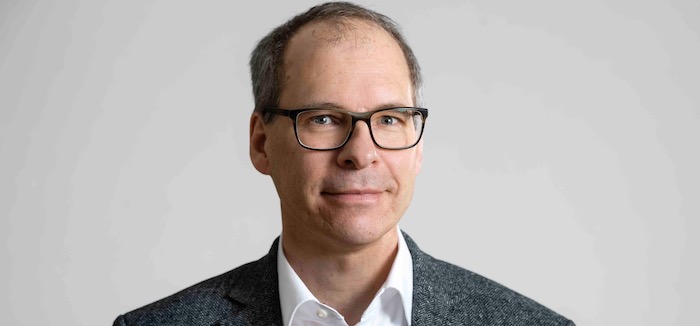Ulrich Schwarz

Institute for Theoretical Physics and BioQuant
Heidelberg University
Philosophenweg 19
69120 Heidelberg
Ulrich Schwarz
... is a theoretical physicist with a strong interest in biological systems, especially if they involve mechanics and force. He studied physics and history of science at Freiburg University, Johns Hopkins University (Baltimore, MD, USA), and LMU Munich. He worked on his PhD in soft matter physics with Gerhard Gompper at the Max Planck Institute of Colloids and Interfaces and received his doctorate in theoretical physics from Potsdam University in 1998. After two years of postdoctoral work with Sam Safran at the Weizmann Institute at Rehovot, Israel, he started his own independent research group on modelling cell adhesion and mechanics, which was supported by the German Research Foundation (DFG) through the Emmy Noether program. Initially at the MPI at Potsdam, in 2005 he moved his group to the newly founded Center for Modelling and Simulations in the Biosciences (BIOMS) at Heidelberg. In 2007 he moved into the newly opened BioQuant-Center on the science campus Im Neuenheimer Feld. In 2008 he was appointed full professor for theoretical biophysics at the Karlsruhe Institute of Technology (KIT). In 2009 he moved back to Heidelberg as professor for theoretical physics at the Institute for Theoretical Physics (ITP), but keeping a second affiliation with the BioQuant. At Heidelberg, Ulrich Schwarz is also a member of the Interdisciplinary Center for Scientific Computing (IWR), of the excellence clusters STRUCTURES and 3DMM2O, of the Max Planck School Matter to Life, of the Flagship Initiative Molecular Systems Engineering and of the CRC 1129 on Integrative Analysis of Pathogen Replication and Spread. In SPP 2332 PoP, he is member of the Steering Committee.
Since 2009 full professor for theoretical physics at Heidelberg
2008 full professor for theoretical biophysics at KIT
2005-2008 BIOMS group leader at Heidelberg
2000-2008 Emmy Noether group leader, first at MPI Potsdam, then at U. Heidelberg
1998-2000 Postdoc at the Weizmann Institute, Israel
1998 PhD at Potsdam University
Research synopsis
When the Schwarz group moved to Heidelberg in 2005 it started to work on the physics of pathogens, including viruses such as HIV and parasites such as Plasmodium, the causative agent of malaria. Together with the Frischknecht lab, we started to investigate the gliding motility of malaria sporozoites, the slender and curved forms that enter the skin. Using traction force microscopy, we showed that the parasite exerts strong forces at the front and rear, and that its force and adhesion patterns are very variable, even when migrating on a flat and homogeneous substrate (Münter et al. Cell Host Microbe 2009). We then studied in detail how sporozoites move in structured environments, in particular in microfabricated pillar arrays (Battista et al. Physical Review E 2014). More recently, we helped the Frischknecht lab to explain why the number of microtubules changes as a function of tubulin expression and why a sufficiently large number is required for successful infection (Spreng et al. EMBO J. 2019). Very recently, we discovered that large numbers of sporozoites from the salivary glands of the mosquito can undergo collective migration in the form of rotating vortices that then can be used to analyse the role of mechanics for sporozoite migration (Patra et al. Nature Physics 2022). In P8 of the SPP 2332 PoP, we now aim to identify the underlying molecular mechanism, in particular what determines the chiral nature of the migration of malaria sporozoites.
In the context of CRC 1129, we also work on the blood stage of malaria infections, in close collaborations with the groups of Michael Lanzer (parasitology) and Motomu Tanaka (physical chemistry) at Heidelberg. In general, we are interested in the molecular determinants of cytoadhesion of malaria-infected red blood cells, which prevents their clearance by the spleen. Recently we were able to show that the central parasite protein KAHRP relocalizes from the ankyrin to the actin junctions during the course of an infection (Sanchez et al. Mol. Microbiol. 2021) and to explain why this comes with a dynamical increase in RBC-stiffness (Jäger et al. PLOS Comp. Biol. 2022).






